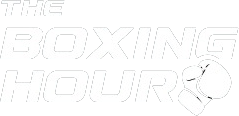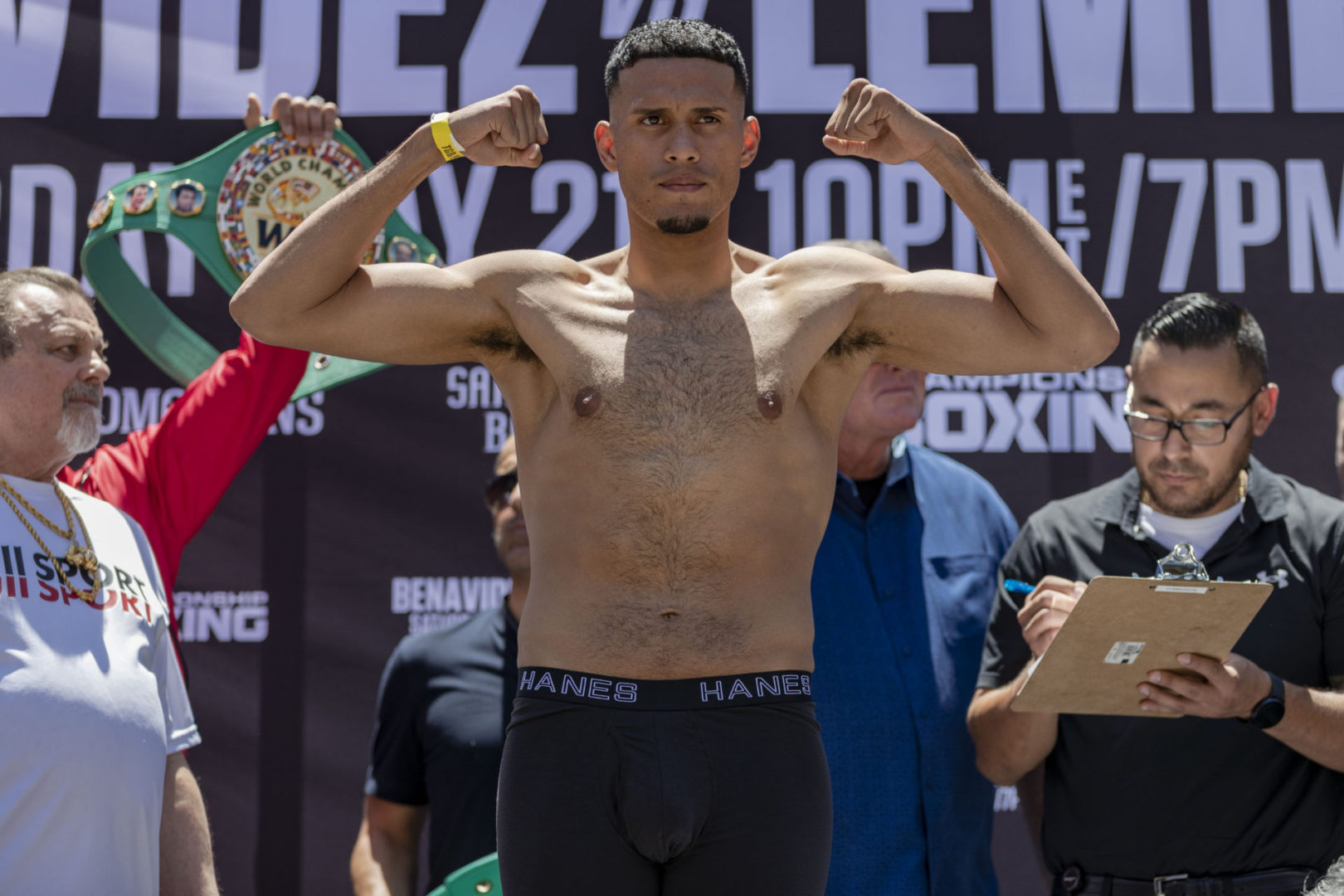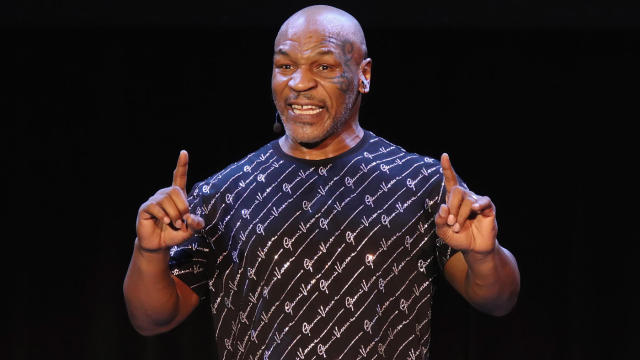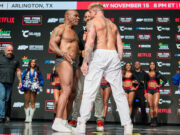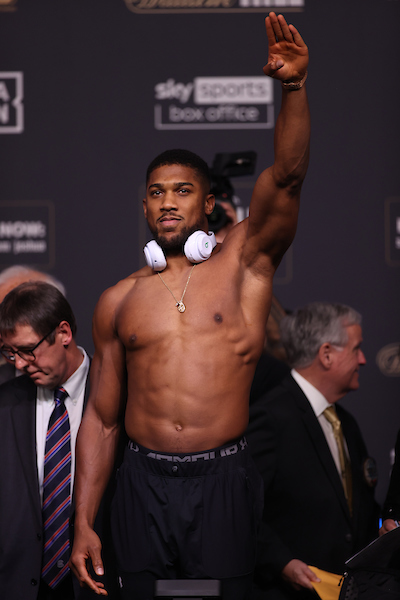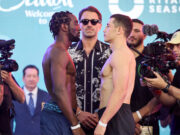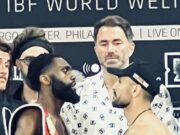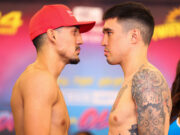Authors Note – In previous years, I’ve broken these treatments into two parts because we needed original content. Kyle Kinder and Anson Wainwright now give us all that and more on weekdays. So here come two parts in one.
Author’s Postscript – Julio Cesar Chavez Jr. vs. John Duddy on June 26 made no one’s Best-of list. Still, it was my favorite event of 2010.
Mosaic (n.) A picture or decorative design made by setting small colored pieces, as of stone or tile, into a surface. 2. A composite picture made of overlapping, usually aerial, photographs.
Dave & Busters restaurant at a place called Crossroads just outside downtown San Antonio, where I-10 and Loop 410 knot, is where assembled media gathered for a rescheduled kick-off press conference to announce “La Furia de México 15” – and neither of the primaries at the press conference would actually be on the fight card.
We were into the opening tosses of our year of discontent by then, May 11, but none of us yet knew how badly the succeeding months, July to November, would go.
As Jorge Arce and Eric Morel addressed the media, after playing a game of pool together Top Rank publicist Lee Samuels fretted was “too friendly,” Rafael Marquez and Israel Vazquez conducted a conference call for their “Once and Four All” fight to happen in Staples Center three states away; one had nothing to do with the other, though Arce was happy to say he couldn’t wait to see the other fight.
“Latin Fury 15” would be announced at Alamodome six weeks before the fight, in a press conference with main-event fighters Julio Cesar Chavez Jr. – son of the legend – and Ireland’s John Duddy, and then it would not be: Chavez had visa issues, and so Duddy, already in town, went for a stroll with manager Craig Hamilton round the Alamo.
I first interviewed Chavez Jr. two days before his 22nd fight – in the concourse of America West Arena – and he was so singularly dull in 2005, so filled with clichés and hedging, that after I asked him two questions I turned to the Univision guys and told them they could have him, and keep him.
Alamodome was nearly empty on May 27, by the time Todd DuBoef and the rest of Top Rank finally corralled Chavez Jr. – though this time not Duddy – into an announcement press conference (a second one; the first somehow happened in Los Angeles), and Chavez was a livelier performer in 2010, though how charismatic could any Mexican look sharing a stage with the eloquence and grace of Marco Antonio Barrera who, with Arce-Morel scrapped, would now share co-main billing?
Jesse James Leija’s ChampionFit Gym hosted an open workout the Tuesday of Fight Week, and after Barrera did some light exercise Freddie Roach arrived and began a full instructional hour with Chavez.
I was startled by how much Chavez struggled with a rudimentary pivot off the ropes – first month of boxing stuff – and so was Leija, though sitting at the apron, he was also surprised by how low Chavez returned his hands while throwing combinations.
Freddie Roach answered questions with a characteristic honesty that makes him great for writers even while it must make him at times maddening to his charges, admitting he wished he’d had more time with Chavez, and that his guy tended to get hit with the very right hands Duddy was adept at throwing, and that, contrary to all ominous rumors, Chavez was a rather likable kid with a great work ethic.
Headquarters for “Latin Fury 15” was the Doubletree hotel just east of I-10 in downtown San Antonio – a Radisson back when Top Rank promoted Pacquiao-Solis from there in 2007 – and it was still too far from the River Walk to offer its guests much of an Alamo City experience.
I sat at a dinner table with Thomas Hauser and Craig Hamilton and marveled at how much Hamilton had read of American history, and how much boxing folks went out of their way to greet Hauser.
In the Doubletree lobby Thursday night, on a set of facing couches, sat Freddie Roach, Thomas Hauser and Bruce Trampler, talking some about boxing, some about Trampler’s mentor Teddy Brenner and lots about Wilt Chamberlain.
The Arneson River Theatre is an amphitheater of white stone steps separated from the stage they view by a loop of the San Antonio River created more than 70 years ago to ensure Texas merchants a fair shot at attracting shoppers – the theatre’s backdrop features the five Hugman Bells that commemorate the city’s founding Spanish missions: San Antonio de Valero (Alamo), San Jose, San Juan, Concepcion, and Espada.
Hot as it was, a goodish crowd of San Antonians assembled on the stone steps Friday afternoon and looked at their river, down which drifted “Latin Fury 15’s” participants on a river taxi; few of us noticed Julio Cesar Chavez Sr., in an Affliction t-shirt and wrap-around shades – a lesson in celebrity’s flightiness.
Chavez Jr. made weight but hopped off the scale quickly, and Craig Hamilton stopped the proceedings, worried his fighter could not get a fair shake in a WBC-sanctioned event held in South Texas – which for 26 years in the 19th century had been part of a newborn country named México.
Saturday afternoon was hot as Friday had been, but San Fernando Gym, a mile or so from Alamodome, was cooler than usual, employing air conditioning for once, while it hosted a 34-bout smoker that ended a few hours before “Latin Fury 15” began.
Saturday morning, my 80-year-old neighbor Walter knocked on my door and told me he’d seen my name in the paper; Express-News’ celebrated boxing scribe John Whisler quoted me saying Mexicans thought Chavez Jr. a “fresa (strawberry),” a child of privilege, whom they wouldn’t mind seeing roughed-up a touch.
There was little to glean at San Fernando that you could use at Alamodome; amateur boxing is a different sport from prizefighting.
Saturday’s co-main event saw Marco Antonio Barrera dissuade and punish and dissuade some more Brazilian lightweight (fighting for Barrera at 140 pounds or so) Adailton De Jesus; Barrera fought back when he had to and boxed the rest of the time, the same way he’d once exposed Prince Naseem Hamed and survived a rematch with Manny Pacquiao.
I listened to the two women who sat in borrowed seats while Hilario Lopez endured a hellacious beating from Houston’s Omar Henry, women who were likely a spouse and a mother/in-law; all they desired was for Lopez to remain upright, and Lopez did, much to his detriment, and the next day when I read Lopez had spent the night in a San Antonio hospital I hoped he would not fight again – and I later learned that, not 90 days later, he was on another Texas card in El Paso.
Junior bantamweight Raul Martinez carried the undercard for San Antonio, stopping his friend Gabriel Elizondo in the seventh round of a fight that would see Martinez hotdog a bit too much for some of his fellow Texans’ tastes – especially those who’d trained with both men.
The conventional wisdom for Chavez-Duddy was simple: If Duddy could make Chavez ignore trainer Freddie Roach and stand in the proverbial phone booth, giving and taking shots, Duddy could prevail in a 12-round fight.
On press row, I wore a pair of navy blue socks with green shamrocks that my dad had bought at a County Cork souvenir shop a decade before, because, well, no other appropriate occasion had yet presented itself.
Duddy probably got the better of Chavez in the opening six minutes, but it would matter little to posterity.
The acoustics for anyone on the southern side of the ring were all wrong because the 9,000-person crowd’s cheers from the north side, where all were gathered, had to float hundreds of empty feet to the back of Alamodome, bounce off the wall and come back, weakened.
The ninth and 10th rounds were when a number of us began to worry about Duddy’s health, as much of a beating as he was catching from Chavez, but Duddy continued to fight back, and Referee Jon Schorle was not likely to stop the match so long as Duddy was upright, in a reminder that our bravest fighters must be protected from themselves.
Chavez knew how to relax in the ring; he was quick to retaliate against punches Duddy landed, but he also appeared calm regardless of what Duddy threw at him, and if Chavez’s unflustered display surprised Duddy a bit he was not alone.
San Antonio enjoyed a good fight, filled with drama more than suspense, a fight in which the strawberry was in fact touched up by a veteran pugilist but listened to his trainer and dished out a whupping of his own, unexpectedly thorough and remorseless.
I had the final tally 117-112 for Chavez, scoring the first round even and all but the second, sixth and 12th rounds for him, too, but how much did it say about Duddy that, having ringsiders worried for his health in the 10th, he’d come back to win the 12th?
Judge Juergen Langos, flown in from overseas to submit a 120-108 score he might have filled-out during the undercard, would reappear in Texas five months later and make a redemptively accurate tally for Pacquiao-Margarito.
The post-fight press conference happened in a room somewhere in the interstices of Alamodome and featured non-media folks – as these things inevitably do.
After the fight, Chavez talked about the next day’s Mexico-Argentina World Cup soccer game – and called his previous self “huevón” – and having proved himself to himself proved to be in all ways more likable than he’d been before, and promoter Bob Arum said at least three times that we had “a new star in boxing!”
A few months after the signature win of his career against John Duddy, Julio Cesar Chavez Jr. returned to form, canceling a tune-up fight and then making a last-moment withdrawal from a pay-per-view card he was to headline, and boxing forgot its “new star” quickly.
The last man to leave the dais at a post-fight press conference, almost without fail, is trainer Freddie Roach; he talks to anyone who approaches him and gives thoughtful answers every time.
I stood beside John Whisler, and we quizzed Roach about Chavez, expressing lots of surprise at how well Roach’s charge had acquitted himself.
There’s a geometry in the ring, a language of space, Roach explained without quite chiding, and if you learn it through immersion at a young age – the way Chavez Jr. must have by watching his father’s myriad of training camps – it is a language you speak fluently, even if you guys don’t believe it about Little Chavez, the strawberry.
Alamodome was empty of all but maintenance workers when the press conference crowd dispersed into the night.
Bruce Trampler told me he had, in fact, read the preview column I wrote and also took exception to the part where I criticized his company’s in-house promotions; he explained how difficult life could be working co-promotions with other companies.
On the drive back to the Doubletree, Trampler said, “I never talk off the record; if there’s something I don’t want to talk about, I’ll say, ‘Bart, I’d prefer not to talk about that,’ but I don’t talk off the record” – and may that someday be every public figure’s approach.
There was a decent crowd in the Doubletree bar 100 minutes after the main event, but Craig Hamilton was still its best-dressed man.
Thomas Hauser, beside whom I’d sat at Alamodome, told me to show Hamilton my shamrock socks, and before I had my right pantleg pulled to my ankle, an Irish accent said “I have to buy that guy a drink!” and a smiling John Duddy walked over.
His face marked but his spirit unblemished, Ireland’s John Duddy stood in the Doubletree bar for an hour at least, posing for pictures with his new Mexican fans, passing cell-phone salutations to their disbelieving spouses, and saying that the Irish-Americans of New York City, those who buy tickets for his Madison Square Garden fights, had taught him an appreciation of Ireland he might not have had otherwise.
Bart Barry can be reached at [email protected].
